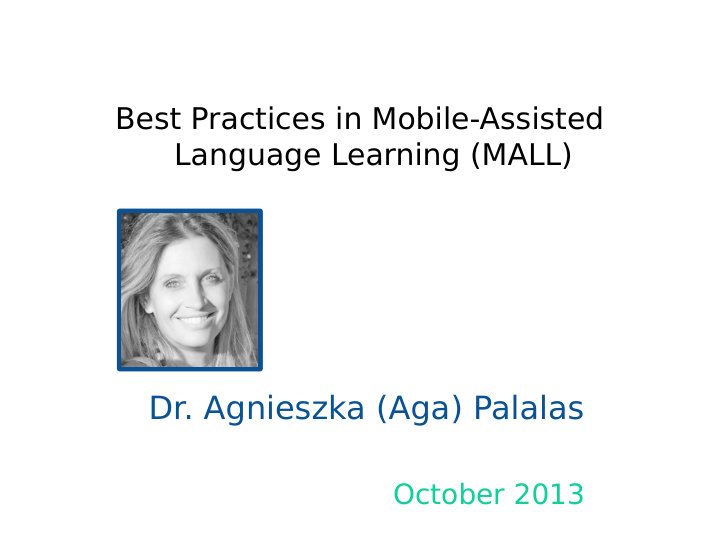



Best Practices in Mobile-Assisted Language Learning (MALL) Dr. Agnieszka (Aga) Palalas October 2013
Best Practices in Mobile-Assisted Language Learning (MALL) Outcome : To identify the best practices for Mobile-Assisted Language Learning design, delivery, outcomes, and learning experience.
Select Benefits of MALL 1/2 •Communication support (all four language skills) •Multimedia support •Portability •Access to language resourc es, supports, scaffolding •Access to mentors, tutors and others learners •Spaced learning in smaller chunks •Situated language practice
Select Benefits of MALL 2/2 •Creativity, fun, engagement •Rehearsal and practice - less threatening environment •Student-centred and personalized learning •Capturing of data, record of learning processes •Language assessment tools •Language games •Scaffolds for group language activities
MALL: Built-in Tools • E-mail • Web browser • Audio and video player • Voice recorder • Camera – photo and video recording • Notes • SMS/texting • GPS
Built-in Tools and Their Application • Audio and video player – podcasts – audiobooks – YouTube videos Voice recorder (Voice Memos, Record) • – record and share speech sample – record parts of the class – replay, rehearse – create mini-stories – record speech for feedback • Camera – photo and video recording – capture communicative situations – record speech sample for evaluation – be creative, e.g., role-play, stand-up comedy
MALL: Mobile Apps • Feedback, polling, student response system – Polleverywhere, Socrative • Vocabulary acquisition – Dictionary.com, WWAudioUS, Flashcard Machine, Flashcards • Speaking and Listening (phloging, pronunciation) – Audioboo, iPadio, Free Audiobooks, Sounds • Integrated – Story creators, Evernote
Emerging Theoretical Framework: Ecological Constructivism Social Constructivism + Sociocultural Theory + • Ecological Linguistics + Contextual and Situated Learning “The recent metaphor of ecology attempts to capture • the interconnectedness of psychological, social, and environmental process in SLA” (Lam & Kramsch, 2003, p.144) ● active learning around real-life problems ● interaction mediated by “cultural tools such as language and technology” (Pachler, 2009, p. 5) ● community-based communication ● scaffolding and guidance ● feedback from facilitators and peers
Ecological Constructivism Learning mediated by communication and interactivity in • social contexts – Learning mediated by the tool • Learning mediated by the context • Learning mediated by the affordance in the context • Affordances: • exist as an initial state in the dynamic environment • represent a relationship (reciprocal interaction) between the • actors (learners) and elements of the environment are for learners to perceive, construe and act purposefully • upon, both individually and in collaboration with others (Palalas & Hoven, 2013)
MALL Listening Tasks (Palalas, 2012)
MALL Tasks • Interconnected tasks • Authentic communication challenges • Co-learning: collaborative and individual • Expert guidance • Interaction: peers, L1 speakers, language experts • Co-created multimedia artifacts • Peer evaluation • Evolving learning resource • Aural focus but integrated all four language skills
Pedagogic Guidelines 1/2 1. Balanced combination of individual and collaborative (group work) tasks 2. Learner-generated linguistic artefacts (audio, video, photos, images) 3. Game-like real-life communicative tasks 4. Expert facilitation : scaffolding, feedback, and coordination 5. Feedback mechanism (immediate and delayed) 6. Focus on authentic listening tasks in the dynamic real- world communicative situations
Pedagogic Guidelines 2/2 7. Support of self-paced individual audio tasks feeding into/preparing learners for the real-life tasks 8. Integrate all four language skills but focus on listening outcomes 9. Linguistic resources (task-related): relevant vocabulary, dictionaries, pronunciation, clear task directions and explanations, examples 10. Support of out-of-class learning with in-class (f2f) instruction and practice (a blend of in-class and out- of-class context)
MALL Procedures (Palalas, 2012)
Re- 1. Replay/re-listen 2. Record 3. Rehearse 4. Repeat 5. Redo 6. Remember 7. Reflect
Co- 1. Communicate 2. Collaborate 3. Connect 4. Co-create 5. Construct 6. Contextualize
Thank you! Dr. Agnieszka Palalas aga@epluslearning.com LinkedIn: http://www.linkedin.com/in/apalalas Presentations: http://www.slideshare.net/agaiza Publications: http://athabascau.academia.edu/apalalas References : • Palalas, A. (2012). Design guidelines for a Mobile-Enabled Language Learning system supporting the development of ESP listening skills (Doctoral dissertation, Athabasca University). Retrieved from http://hdl.handle.net/10791/17 • Palalas, A., & Hoven, D. (2013). Implications of using DBR to investigate the iterative design of a mobile- enabled language learning system. CALICO.
Recommend
More recommend